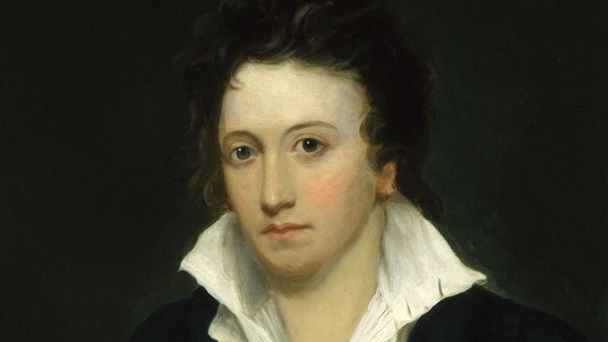“I curse thee! let a sufferer’s curse…

Ahh, if only we all possessed the ability to curse our enemies in such a romantic tongue. Alas, we do not and we must leave that beautiful power to those who truly deserve it. On this day, we honor poet Percy Shelley – one of the most famed English Romantic poets and author of Prometheus Unbound – from which the above section was unabashedly taken.
Percy Shelley was born on the 4th of August, 1792 in a small village in West Sussex. He was the oldest of 7 children, and seemed to always run a bit wild! He left home to be educated formally at the age of 10, and at 12 enrolled in Eton. Unfortunately Shelley was heavily bullied at Eton College, and while such behavior is never requested it certainly seemed to help build Shelley’s inner imagination up and he began writing at a young age. At 18 he began his studies at University College, Oxford. Shelley excelled academically at the start, but after just a few months was expelled after writing a pamphlet promoting atheism with another student and refusing to confirm or deny his authorship in it (which in and of itself is kind of a confirmation, no?). Shelley’s life was nothing but static. He experienced bouts of grave financial difficulty (his parents being unamused, to say the least, of Shelley’s difficult nature), and had what were considered extremely radical notions for the times. He believed in free love and vegetarianism. For the turn of the 19th century those were novel ideas, to say the least!

Shelley wrote to support himself after running away at 19 with a 16 year old girl that his parents had expressly forbidden him to see. The couple were happy for only a short period of time, however, as Shelley was quickly bored by Harriet and his conceptions of free love kept him from the marriage bed. Shelley was eventually able to boast a mentorship from one of his political and philosophical idols – William Godwin – where Shelley discovered both his own political radical ideology and Godwin’s daughter, Mary. Mary Godwin was the daughter of a powerful political and intellectual duo, being begot of Godwin and Mary Wollstonecraft. Mary turned Shelley’s world upside down and the two fell deeply in love, risking family disinheritance to be together. The two, along with Mary’s sister Jane, fled their homes and lived as vagabonds, traveling around England and Europe (often by foot) for over three years. By the time they returned, Shelley’s wife Harriet had had enough and had filed for divorce.
 In the summer of 1816, Shelley befriended one of his first powerful and influential authors – Lord Byron. Percy and Mary spent a season with Byron in Switzerland – the summer ended up being one of the most important of Shelley’s life. Byron helped inspire the young radical, and Shelley wrote his romantic poem Hymn to Intellectual Beauty after an afternoon with Byron. It was during this summer, funnily enough, that Byron’s guests and friends were inspired to have a horror write-off. This writing competition of sorts was the inspiration behind Mary Shelley’s Frankenstein. Upon their return to England at the end of the year, it was discovered that Shelley’s wife, Harriet, had committed suicide. As unfortunate as the event was, it incited Shelley and Mary to finally marry. The two settled in a small hamlet in Buckinghamshire, where they befriended poets John Keats and Leigh Hunt – both of which would prove to be invaluable friends to Shelley in his last years. It was in these years that Shelley wrote and published a bulk of his most well-known works, including The Revolt of Islam and Prometheus Unbound, the latter of which is widely considered to be his most beloved epic work.
In the summer of 1816, Shelley befriended one of his first powerful and influential authors – Lord Byron. Percy and Mary spent a season with Byron in Switzerland – the summer ended up being one of the most important of Shelley’s life. Byron helped inspire the young radical, and Shelley wrote his romantic poem Hymn to Intellectual Beauty after an afternoon with Byron. It was during this summer, funnily enough, that Byron’s guests and friends were inspired to have a horror write-off. This writing competition of sorts was the inspiration behind Mary Shelley’s Frankenstein. Upon their return to England at the end of the year, it was discovered that Shelley’s wife, Harriet, had committed suicide. As unfortunate as the event was, it incited Shelley and Mary to finally marry. The two settled in a small hamlet in Buckinghamshire, where they befriended poets John Keats and Leigh Hunt – both of which would prove to be invaluable friends to Shelley in his last years. It was in these years that Shelley wrote and published a bulk of his most well-known works, including The Revolt of Islam and Prometheus Unbound, the latter of which is widely considered to be his most beloved epic work.
Sadly, Shelley would not live to see his work widely recognized, as he died when his boat capsized in a storm just shy of his 30th birthday. As was the custom, Shelley was buried in the sand on the beach where he washed up for one month before being dug up and burned on a funeral pyre. It is said that his heart refused to burn – and that his friend Leigh Hunt retrieved it from the ashes and gifted it to Mary Shelley – who kept it in a writing case wrapped in silk for the rest of her days. Oh, what a terrifying thought!

Shelley’s young works showed all the aspects of the talented writer that he was, if only he had been able to live longer and reach his full potential. But as Shelley once said, we must “fear not for the future, weep not for the past.” Well said.

